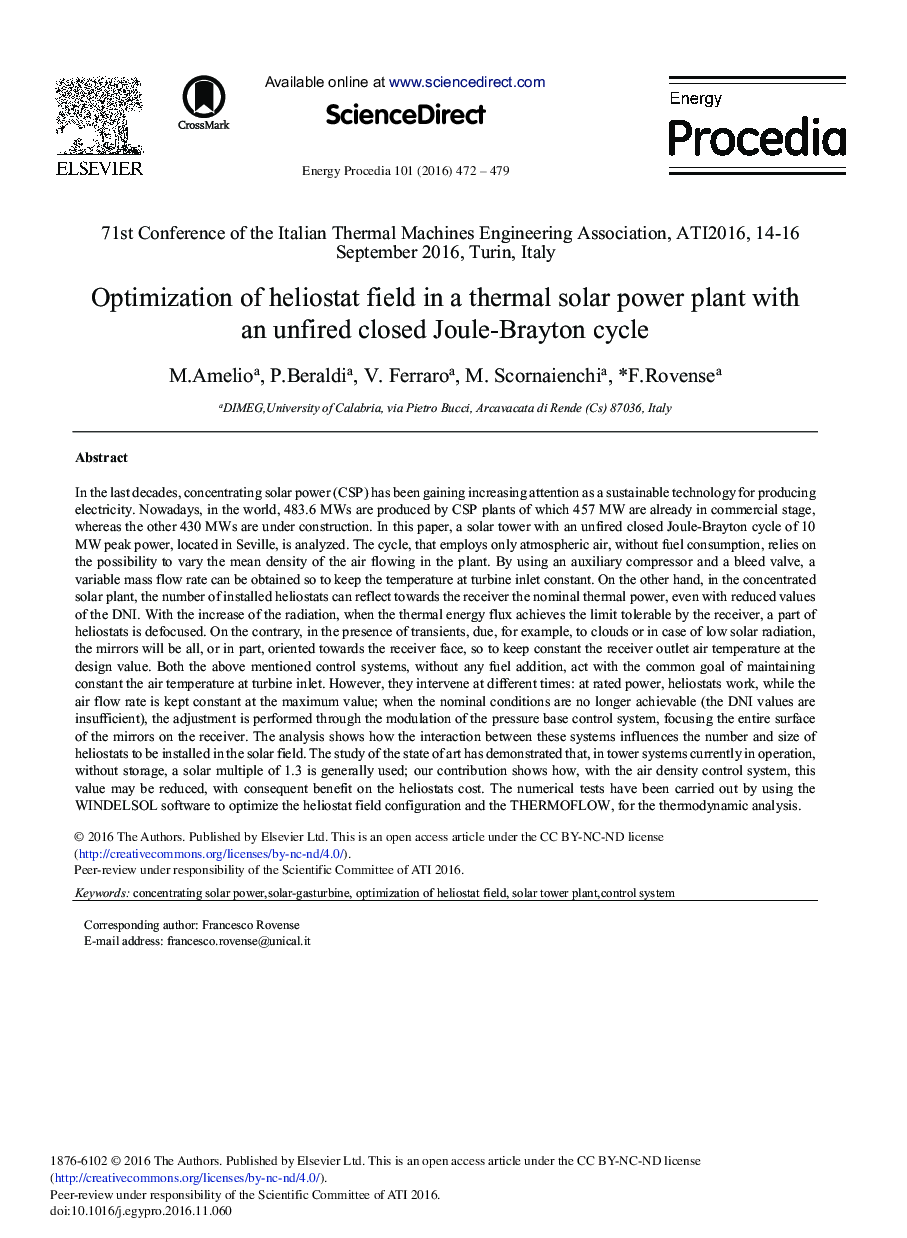| کد مقاله | کد نشریه | سال انتشار | مقاله انگلیسی | نسخه تمام متن |
|---|---|---|---|---|
| 5446488 | 1511134 | 2016 | 8 صفحه PDF | دانلود رایگان |
عنوان انگلیسی مقاله ISI
Optimization of Heliostat Field in a Thermal Solar Power Plant with an Unfired Closed Joule-Brayton Cycle
ترجمه فارسی عنوان
بهینه سازی میدان هلیوواستات در یک نیروگاه خورشیدی حرارتی با یک دوره ی خنثی نشده ی جول بریتون
دانلود مقاله + سفارش ترجمه
دانلود مقاله ISI انگلیسی
رایگان برای ایرانیان
کلمات کلیدی
تمرکز نیروی خورشیدی، خورشیدگرفتگی، بهینه سازی میدان هلیستات، گیاه خورشیدی برج، سیستم کنترل،
موضوعات مرتبط
مهندسی و علوم پایه
مهندسی انرژی
انرژی (عمومی)
چکیده انگلیسی
In the last decades, concentrating solar power (CSP) has been gaining increasing attention as a sustainable technology for producing electricity. Nowadays, in the world, 483.6 MWs are produced by CSP plants of which 457 MW are already in commercial stage, whereas the other 430 MWs are under construction. In this paper, a solar tower with an unfired closed Joule-Brayton cycle of 10 MW peak power, located in Seville, is analyzed. The cycle, that employs only atmospheric air, without fuel consumption, relies on the possibility to vary the mean density of the air flowing in the plant. By using an auxiliary compressor and a bleed valve, a variable mass flow rate can be obtained so to keep the temperature at turbine inlet constant. On the other hand, in the concentrated solar plant, the number of installed heliostats can reflect towards the receiver the nominal thermal power, even with reduced values of the DNI. With the increase of the radiation, when the thermal energy flux achieves the limit tolerable by the receiver, a part of heliostats is defocused. On the contrary, in the presence of transients, due, for example, to clouds or in case of low solar radiation, the mirrors will be all, or in part, oriented towards the receiver face, so to keep constant the receiver outlet air temperature at the design value. Both the above mentioned control systems, without any fuel addition, act with the common goal of maintaining constant the air temperature at turbine inlet. However, they intervene at different times: at rated power, heliostats work, while the air flow rate is kept constant at the maximum value; when the nominal conditions are no longer achievable (the DNI values are insufficient), the adjustment is performed through the modulation of the pressure base control system, focusing the entire surface of the mirrors on the receiver. The analysis shows how the interaction between these systems influences the number and size of heliostats to be installed in the solar field. The study of the state of art has demonstrated that, in tower systems currently in operation, without storage, a solar multiple of 1.3 is generally used; our contribution shows how, with the air density control system, this value may be reduced, with consequent benefit on the heliostats cost. The numerical tests have been carried out by using the WINDELSOL software to optimize the heliostat field configuration and the THERMOFLOW, for the thermodynamic analysis.
ناشر
Database: Elsevier - ScienceDirect (ساینس دایرکت)
Journal: Energy Procedia - Volume 101, November 2016, Pages 472-479
Journal: Energy Procedia - Volume 101, November 2016, Pages 472-479
نویسندگان
M. Amelio, P. Beraldi, V. Ferraro, M. Scornaienchi, F. Rovense,
